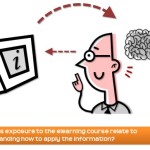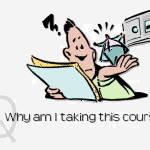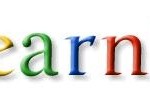[…] […]
10 Free Audio Programs to Use for E-Learning
June 1st, 2010
I’m no audio engineer. And odds are that neither are you. So I won’t get into all of the nitty gritty details of audio editing. If you want more details, one of the community MVPs shared some tips on how to improve your audio quality. It’s a good post and worthy reading.
Today I want to share some free or inexpensive ways to work with the audio in your elearning courses. Let’s start with narration.
Do the Basics Right
Your audio quality is never going to be better than what you originally recorded. So you need to do the best you can to record good quality audio from the start. The two best things you can do are:
- Invest in a good microphone. I’m surprised that organizations will invest hundreds of dollars in software, pay someone thousands of dollars to build courses, and then only let them buy a cheap microphone for $20. Makes no sense. Even if you’re on a limited budget, you can get a good microphone for about $50.
- Control your recording environment. If you record in a conference room next to the copy machine or at your office cubicle, odds are that you’ll have sub-par audio. Try to find a consistent place to record audio so that you can better control your environment.
You can find some additional tips in these posts on recording high quality audio and recording narration like a pro.
Audacity
I’ve mentioned Audacity before. It’s an audio editor that is free and easy to use for beginners. But if you want to do more than basic editing, you have a lot of features to work with. So it’s a tool that you can grow into.
Here’s a good tutorial from Brian that shows how to clean up your audio starting with those “little itty bitty” wave forms.
Click here to view the screencast.
If you want a little bit more detail, David did a few tutorials that show how to edit your narration for greater impact.
- Use bass boost to add warmth
- Reduce background & ambient noise
- Equalize to add warmth and presence
- Clean up your audio (good tip from Brian)
Myna (out of business)
Aviary’s Myna is an online audio editor. It’s easy to use; and as long as you have a decent Internet connection, it’s a practical tool. It’s also free, which is a big plus. What I like about Myna is the library of assets available to you.
I did a quick screencast to show how it works. If you want to learn more, go to the site and check out the demo and tutorials.
Click here to view the screencast.
Levelator
Levelator is a really simple way to make some improvements to your audio narration. I can’t think of any easier way to adjust your audio. Basically, all you do is drag and drop you audio files onto the desktop shortcut and the application does the rest. Levelator does its magic and provides edited copies right inside the same folder.
Below is a quick tutorial that shows just how easy it is to use. I’ve also added a before and after audio file to hear the difference. It’s a little richer and louder. You can also see the differences in the wave forms below.
Click here to view the tutorial.
Creative Commons Audio
The tools above ar
e free and help you get better sounding audio. But sometimes our audio needs aren’t just for narration. Sometimes we need background music or sound effects.
If you have some money you can always buy background music and sound effects on CD. When I did video production, we had a CD binder that held about 200 disks full of just about any music style you would need. It was a great resource.
Even if you don’t have money, there are some free resources available to you. Here are a few sites that offer sound effects and free music. Be sure to check out their Creative Commons License agreements before using them.
- CCMixter. Loved this song, Making Me Nervous, which I heard in a Tech Crunch video.
- The Freesound Project: I even included one. Do a search for “elearning.” 🙂
- OpSound
- Free Music Archive
- Jamendo
Another option is to buy stock sounds. I’ve used Soundsnap before. iStockphoto also sells stock audio. They have a good library and the prices are decent.
Another idea is to contact an independent artist who may give you permission to use some music. It never hurts to ask. Of course, even a good song can’t make a bad course enjoyable.

Create Your Own Audio
When all else fails you can create your own audio files. If you want simple sound effects, record your own. Need ambient office noise? Just set up a mic in a busy area and record the audio. Or go to the cafeteria. That’s what Chris Kelly did to get the busy pub sound for his Beer Brewing Overview. Love the tips on sustainable brewing. 🙂

You can even create your own music. You can create everything from a hip hop beat to softer background audio. Musicshake and TuneAround are free tools that let you easily create your own music and soundtracks. Be careful, though. You can end up spending hours playing around and creating your own music. As an example, I used Musicshake to create Dr. Werner’s SMART Goals: The Musical.
You can always download and use Microsoft’s Songsmith and create brilliant stuff like this. The video kind of reminds of all of the lame training programs I’ve been in where we had to write and perform songs based on what we learned.
Click here to watch the Songsmith video.
I’m not sure what Microsoft is thinking or why anyone would pay $30 for it considering the alternatives above, but Songsmith is available for free to educators. Based on how my kids have played with it, I can see where this could be a good tool to use in class as part of a creative exercise. For example, write a song about something you learned.
So those are some simple tools that you can use when including audio in your rapid elearning courses. Have any other free audio tools to recommend? Feel free to share them in the comments link.
Events
- Everyday. Check out the weekly training webinars to learn more about Rise, Storyline, and instructional design.
Free E-Learning Resources
 |
 |
 |
|
Want to learn more? Check out these articles and free resources in the community. |
Here’s a great job board for e-learning, instructional design, and training jobs |
Participate in the weekly e-learning challenges to sharpen your skills |
 |
 |
 |
|
Get your free PowerPoint templates and free graphics & stock images. |
Lots of cool e-learning examples to check out and find inspiration. |
Getting Started? This e-learning 101 series and the free e-books will help. |
35 responses to “10 Free Audio Programs to Use for E-Learning”
Awesome tips and tutorials for audio production.
I’ve been working with audio for sometime now and the tips you share are great for instructional designers that want to integrate audio in their projects.
Good work!
As unofficial spokesperson for the oppressed and ignored minority (Mac users), don’t forget my personal weapon of choice, Apple’s GarageBand – free with any new Mac. 😉
GarageBand provides excellent multitrack recording and editing, nice audio effect presets, including podcasting and narration presets, and it also comes with lots of music samples and sound effects you can stitch together to create your own custom soundtrack (and other sound collections, called Jam Packs, are available from Apple at a reasonable price). GarageBand is a solid app that’s easy (and enjoyable) to use. I use it for all my eLearning narration work.
Oh, and negative points for embedding the horrific Songsmith ad (ouch). But bonus points for the sticker-covered MacBook Pro in the ad. Looks like you break even. 🙂
Excellent tips!Thanks for sharing.
Chris, don’t feel oppressed and ignored. Most of us envy you, but we have our operating systems forced on us by our overlords. It is WE who are oppressed and ignored.
Back on script, why do Brian and David copy their audio track to make it stereo? For music, or perhaps a diologue between two people, I can understand. But for a single voice, expecially when the other track wasn’t modified to actually create a stereo effect, seems like a waste of bandwidth. My audio tracks are some of my biggest files. Making my narration stereo doubles the size of those files.
[…] This post was mentioned on Twitter by Carla Arena, Deanna Stall. Deanna Stall said: RT @poochiesan24: 10 Free Audio Programs to Use for E-Learning http://icio.us/nvp5wc […]
Great post! I have to agree with Jim Dickeson about Stereo tracks. When you’re just sending off vocal audio, unless it’s more than one voice having to be mixed, there’s no need for a stereo file. To keep it simple, one in = one out. If there is a music or sFx track, you can still bounce out your final product in Mono, but most keep it in Stereo. Again, to put it simply, 2+ in = Stereo out.
Many have trouble with the portability and speed of loading their audio and keeping it small helps. So, Mono should be the Channel of Choice”. This also is important in PPT presentations as well, since those files many times are heavier on the program having to be in WAV.
Also, I like Levelator for some things, but it tends to make the audio too hot for some productions. It’s best for when you have several voices to “match” levels easier.
As far as equalization and adding bass, I don’t do this on raw vocal narration, I do a basic clean-up, correct any DC Offset, correct my levels and bounce it out into an MP3, and that’s it.
All that changes if I’m mixing sFx or music. And for that, it’s on a case by case basis.
I would like to add WavePad ( http://www.nch.com.au/wavepad/index.html )as an excellent free resource for audio editing. One of the reasons I like this program is the ability to batch convert files from one format to another. This is especially useful for those occasions where, despite your best efforts, your audio you receive has different formats. Also, it has some easy to add effects, such as the telephone effect. This effect is pre-loaded and is great for coursework with dialog, such as those in language studies.
Chris,
As a fellow Mac user (are you Parallels 5 or VM Ware 3?), I empathise and recommend the music loops that come with iLife in addition to your suggestions.
I still record in Audacity, but GarageBand is good for mixing tracts.
You’re not alone,
@jenisecook
(From my iPad.)
Hello Tom, interesting post! Thank yoou!
Especially the Myna tool got my attention. But here’s a question: since the assets are free – may I use my creations for free too? I mean in my e-learning courses…
Greetings from Berlin, Germany!
David
Thanks for the tips Tom. I’ve just recently purchased a new mic Samson and have been tweaking different things to make it sound better.
By the way, that Songsmith video is fantastic! It cracks me up every single time I force myself (or someone else) to watch it!
There are a few others that you may want to look at. If you fancy, here is a Moodle course using many audio tools: http://fslearning.net/moodle/course/view.php?id=263
Look down the right hand side of the screen for links to tools and resources.
[…] So Tom Kuhlmann does a great service by telling you what you need to know about sound for e-learning. […]
Tom
This information was timed perfectly as I was quite unsatisfied with the quality I was getting but you have helped me improve that. I also would recommend people check out ArticuateBrian and his screer’s on Audio, they are great as well.
@Tom I have been meaning to do some basic tutorials for some time. I’ll let you know when I get it done!
“Thanks to Songsmith now we’re singin’ all the time. And what a happy home we’ll have with every word in rhyme!”
I’ll have that jingle in my head all day now
Thanks for making my day, Tom! 🙂
[…] 10 Free Audio Programs to Use for E-Learning […]
[…] 10 Free Audio Programs to Use for E-Learning Leave a Comment […]
[…] I’m no audio engineer. And odds are that neither are you. So I won’t get into all of the nitty gritty details of audio editing. If you want more details, one of the community MVPs shared some tips on how to improve your audio quality. It’s a good post and worthy reading. Today I want […] Original post […]
Is there a tool that will break down an existing song into its many layers? Can I use any part of an existing song without having to ask its creator for permission (e.g it’s OK to use no more than 5 seconds of an existing song to create a loop)?
This is great. Is there any place I can view a comparison of them all in one format such as a chart or table?
[…] The Rapid eLearning Blog […]
[…] 10 free Audio Programs […]
[…] Following are the ten audio sites that I profiled. You can get more detail from the original post. […]
[…] 10 free Audio Programs […]
[…] Myna: easy-to-use online audio editor that includes a library of assets. [original post] […]
Hi Tom,
I seem to remeber having read somewhere on your blog that you can go to a website to get someone (with a good voice)to record the audio for projects. However, I can’t trace it. Can you please let me know.
Kind regards.
[…] Aviary’s Myna is an online audio editor. It’s easy to use; and as long as you have a decent Internet connection, it’s a practical tool. It’s also free, which is a big plus. What I like about Myna is the library of assets available to you. I did a quick screencast to show how it works. 10 Free Audio Programs to Use for E-Learning » The Rapid eLearning Blog […]
[…] 10 Free Audio Programs to Use for E-Learning » The Rapid eLearni […]
[…] tools above are free and help you get better sounding audio. 10 Free Audio Programs to Use for E-Learning » The Rapid eLearni Multimedios E-mails Sons Sound Audio [+] Educational Tools convert Websites On Cloud 9 […]
[…] 10 Free Audio Programs to Use for E-Learning If you’re like me, when you use PowerPoint to build your rapid elearning courses, you end up doing a lot of copying and pasting of objects. […]
[…] 10 Free Audio Programs to Use for E-Learning SkreemR MP3 Search: Find, Play and Download free songs, music and MP3s DOWNLOAD MUSICA E SUONI […]
You may want to try Magix Audio Cleaning Lab. I have been using it for 5 years now with a Samson mic. You can correct a word or sentence with ease, simply record the new word/sentence and splice it in. No one will know the difference!









0
comments